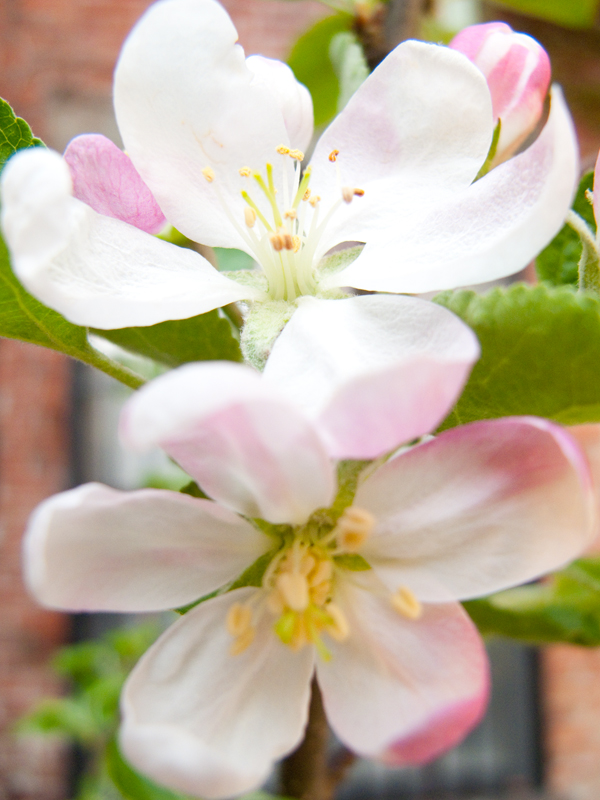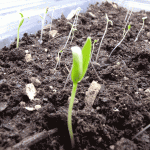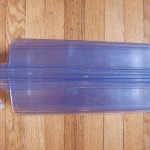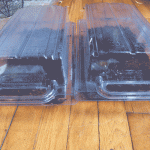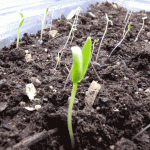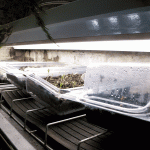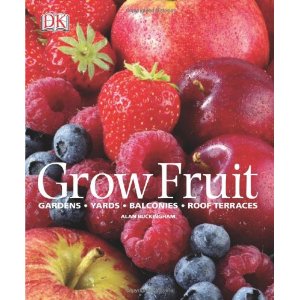Here’s a video showing a rooftop hydroponic gardening system. Looks like a great, albeit costly, option for city rooftops. The system that is shown is by a company called Tower Garden.
Category Archives: gardening
Raised Bed Planters
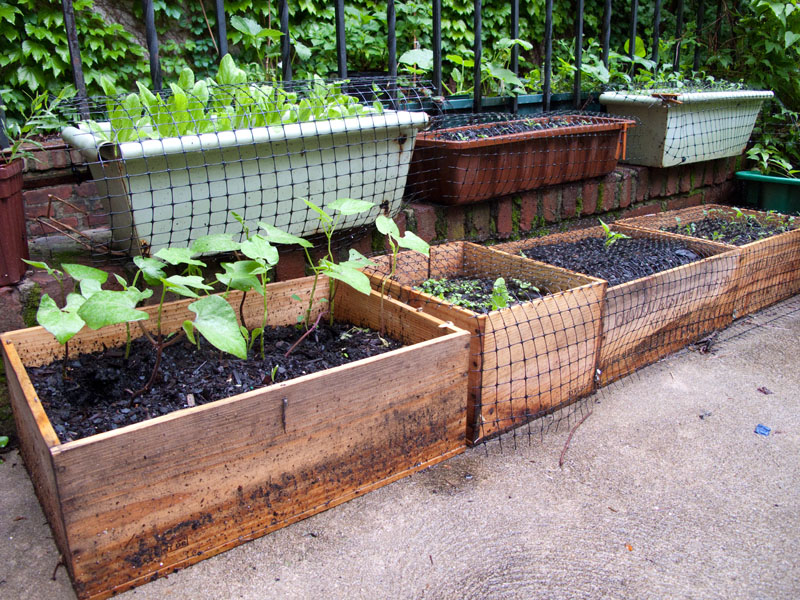
As I’ve probably mentioned before, I have a tiny backyard surrounded by tall buildings. What this means is that for several hours a day (more in winter) the sun is blocked by these buildings. So while my yard looks sunny, the sun travels and doesn’t hit one spot all day long.
The spot that gets the most sun is (of course) the area that is paved. I have had an assortment of pots and planters there, and this year I put in some raised bed planters. Instead of building them, I scavenged wooden wine boxes from our local wine shops. They are the same width (wine bottle length), so even though they are different lengths, they make a nice, even row.
I have to be somewhat smart about what I can plant with my limited sunshine. I have bush beans, lots of greens including mâche, deer tongue, new zealand spinach and lacinata kale. I can grow tomato plants that don’t produce a lot. Cherries do best. This year I planted white currant tomatoes. I have way too many, since I started them from seed, so if anyone wants some, let me know.
I am trying yukon gold potatoes and ground cherries for the first time.
And if you are wondering why I have wire over my beds, it’s because I have very tenacious squirrels. They dig like lunatics in my beds, which rips up anything that isn’t well established.
Baby Apples
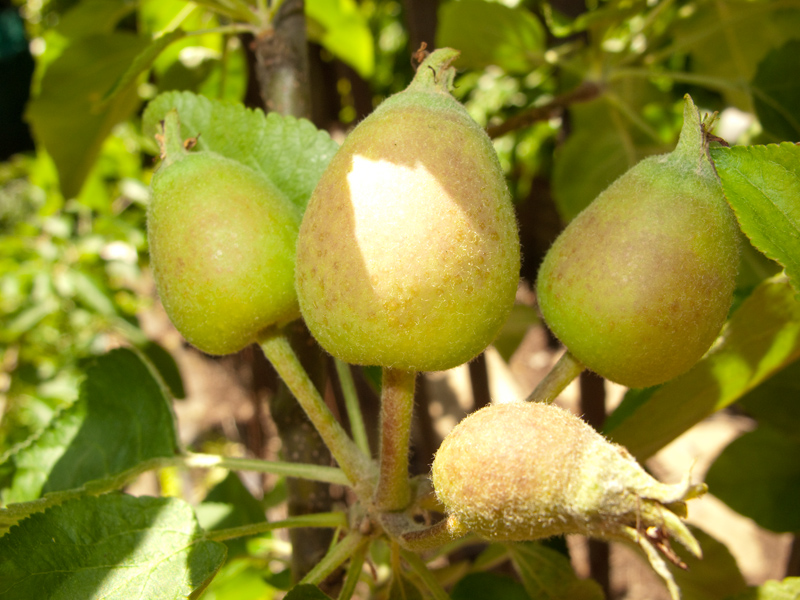
You may recall a couple of weeks ago I put some blossoming apple branches into my backyard to try and pollinate my little apple tree. I didn’t have high hopes that it would work, but if looks don’t deceive me, I have baby apples. They are about 1.5 inches in diameter and there are about 8 of them.
I ordered a tiny twig of an apple tree, which arrived a week or two ago. What’s completely amazing is that this puny little runt of a tree is blossoming! I thought I would have to wait a couple years like I did with my first tree.
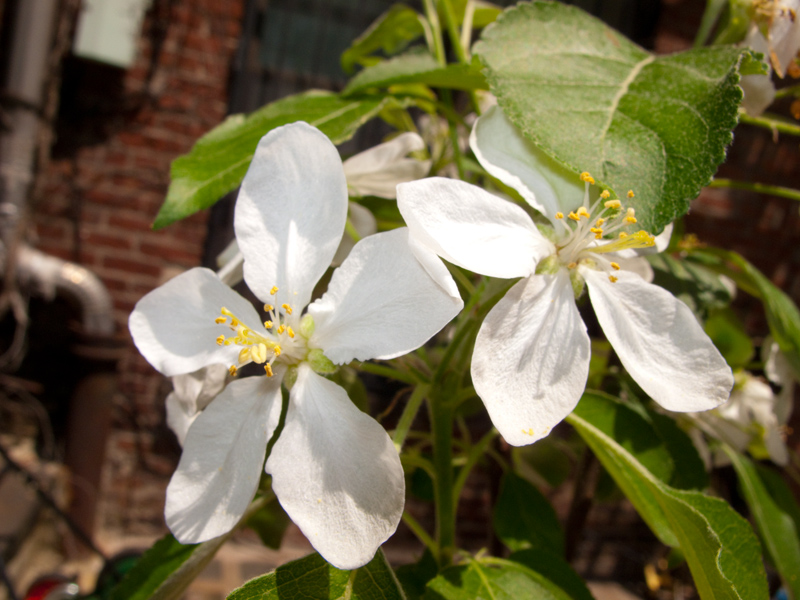
I’m going up to my in-laws house this weekend and might get greedy and bring back some of their apple tree branches which are blooming right now. Maybe I can pollinate my little tiny tree and get an apple or two it’s first year.
Pollinating my apple tree
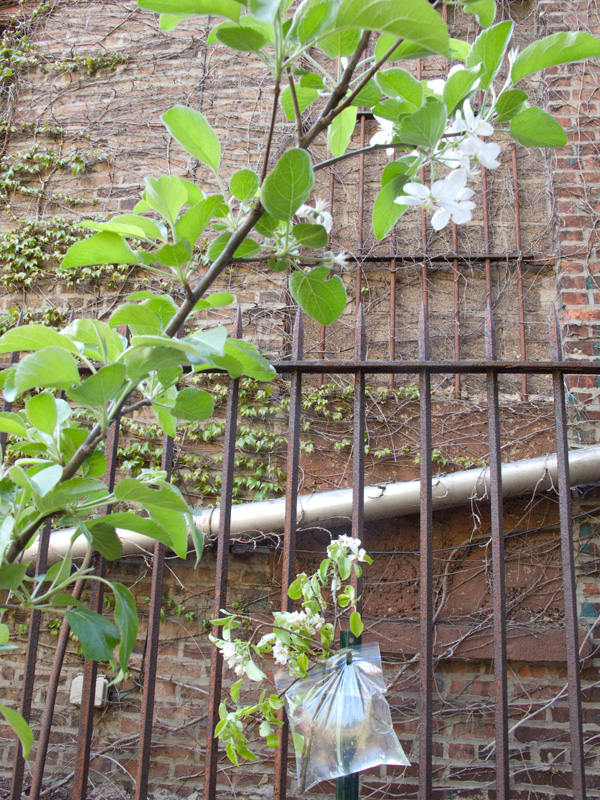
If you’ve read my earlier post, you will know that I was in need of a second apple tree to help me cross-pollinate my dwarf apple tree. I mentioned this to my sister, and she said all I might need are a few flowering branches from someone else’s tree. If I put the branches out in my garden near my tree, the bees could do their work and I might get apples this year.
So where does a city girl get flowering apple branches? I posted on Brooklyn Freecycle, but didn’t get a response.
I went to a synagogue a few blocks away that has a neglected apple tree on its property, but I think they thought I was nuts. (I’m getting used to this response in people) The woman who had to make the decision never called me back. My next, best option was to prune some branches from the apple trees where we went morel hunting. And this I did. I did notice that quite a few of the trees were actually crab apple trees, which wouldn’t help me out. In fact, I already have a crab apple tree in my yard.
The branches made it home without wilting too much. I put them in water and hung one from the support of my tiny, new tree. I also brushed the stamens/pistils from the pruned flowers onto my flowers just in case I didn’t have bees visiting my yard. Now, let’s cross our fingers for some fruit.
How to plant a dwarf apple tree
As you may have read from a previous post, I ordered a second apple tree to serve as pollinator to my current tree. My first tree is a Sundance apple. The new tree is a Pixie Crunch.

If you get a bare-root tree, as I did, you will need to immediately soak the roots in water (in the shade) for a couple of hours.
Then fill your container with good soil. I added compost from my garden, which is rich in nitrogen from my chicken’s manure. Make sure to keep the graft (the bumpy join in the trunk) a couple of inches above the level of the soil. My tree has a white line painted on to show the join.
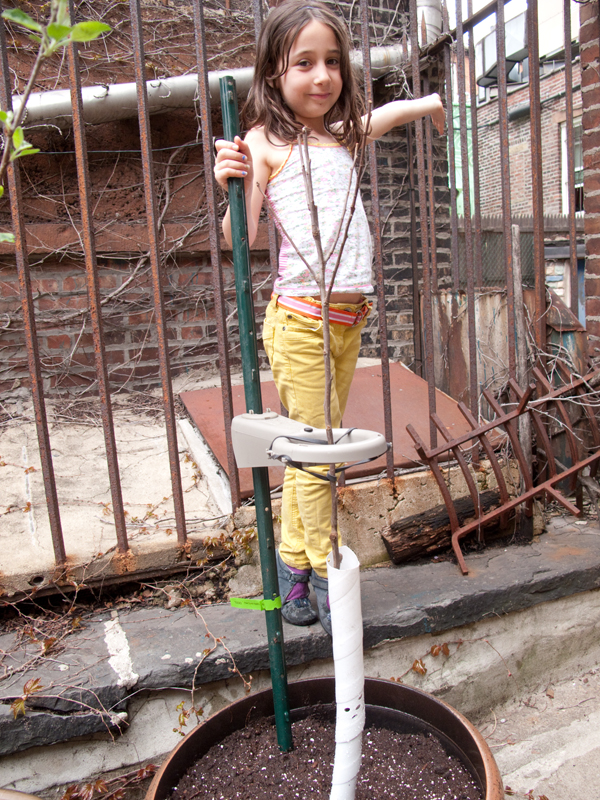
I put a support post in as well and added a protective guard for the trunk. Hungry squirrels will chew on the bark of a young tree. I had this happen to my first apple tree. Fortunately it didn’t harm the tree. I added a guard around that tree as well. This set-up looks like overkill, but the tree will quickly grow into it.
When you have your tree in place, pat the soil down and water it well. Keep watering the newly planted tree if you have less than an inch of rainfall per week.
It takes two to tango
Two years ago I started to plant fewer flowers, and more edibles. I put in 4 blueberry bushes, 2 elderberries, 2 currants, 2 gooseberries and one apple tree. Waiting for the plants to mature enough to bear fruit has been excruciating. Last year we had blueberries, but nothing else yet.
Now you might already know what is wrong with my equation above, but embarrassingly enough I didn’t. This is going to be a ridiculous reveal in about five seconds. This past winter something kept bothering me about my apple tree. I didn’t really give it much thought, but doubts would creep in right before going to sleep, only to be completely forgotten by morning. Then the absolutely most obvious and embarrassing realization hit me. I need two freakin’ trees to pollinate each other!!! Crap, crap and double crap! I’ve had this tree for 2 years and now I would have to get a new one that would take a couple of years to mature. That’s 4 years of waiting for fruit! Gah, how could I be so stupid?? I quickly placed an order for a new tree. I even asked the lady if my crabapple tree could pollinate my apple tree. She tried not to laugh at the city girl.
The only tiny bright spot is that my sister told me the other night, that I could prune some branches off a different apple tree and put them in a vase near mine. That is supposed to be able to pollinate my tree. I’m going morel hunting this weekend at an apple orchard, so I’m going to try that. Cross your fingers!
Seed Starting
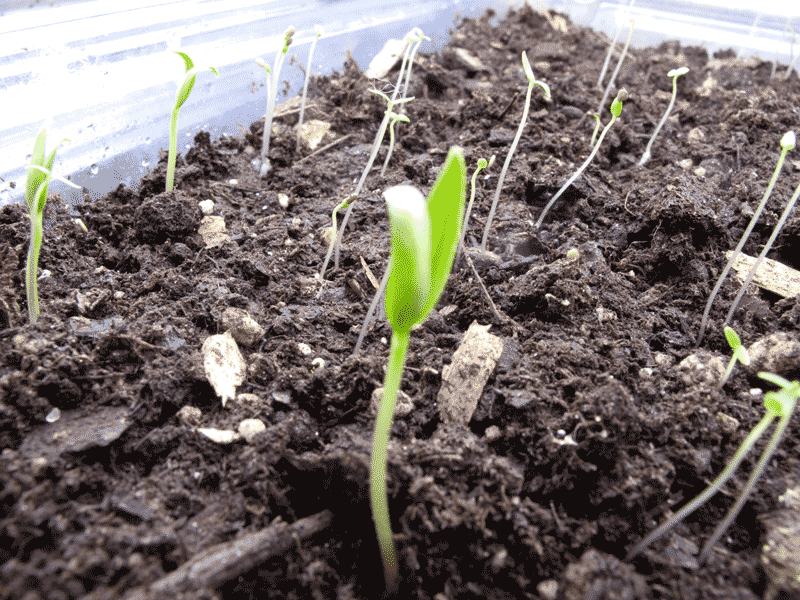
This could be my favorite time of the year. Winter is ending. (Please, humor me) Flowers are starting to pop, trees are blooming and there is an exuberance in the air when we can finally shed the heavy winter coats.
I like planting seeds because it gets me dreaming of warm summer days and the joy of growing my own flowers and veggies. We’ve had an unusually long winter, so I wasn’t thinking about starting seeds until just recently.
I like to recycle, so when I was walking down my street last fall, I saw these plastic containers being tossed and thought they would be perfect for starting seeds. You can also use those ridiculous plastic tubs that washed salad greens come in. It might make you feel less guilty for buying something with so much packaging! There were loads of these containers, so I kept a few and gave a bunch to my daughter’s science teacher, who runs a gardening class at the school.
I was talking with my mother-in-law about starting seeds and how I don’t do much besides putting the containers in a warm place, which is usually in a sunny spot. I poo-pooed all the “helicopter parenting” for seed starting. However, after several days with no signs of sun, warmth or seeds, I decided to pull out a heating mat I bought years ago for seed starting. That did the trick for getting the little guys to germinate. We still haven’t seen any signs of sun in ages, so I also pulled out the grow light that’s been in my basement for years.
So now the jokes on me and I’m the helicopter seed parent. Hopefully it will warm up enough that I can put these guys outside during the day and turn off the electricity. I did plant kale, deer’s tongue lettuce, New Zealand spinach, bush beans, sweet peas and mixed greens outside.
Inside started borage, which is growing like crazy, white currant tomatoes (little heirloom cherries) and ground cherries. I also planted the ironweed seeds that my mother-in-law gathered from the native plant nursery Project Native.
Growing Fruit
One area of gardening that still intimidates me is pruning. Especially when it comes to fruit trees. Two years ago I bought a dwarf apple tree and have been afraid to touch it. So far it hasn’t matured enough to produce fruit. Last year I saw one blossom, but that didn’t stick around long enough to make an apple. We had a weird, dry summer, so that wasn’t a surprise. This coming summer, I really want to see some action with this little tree. I think some judicious pruning, might help it along. That is why I got this book yesterday.
I had some fantasies about training the tree into a fancy, espaliered form, but I think I will just stick with a basic tree. Besides, a fancy, formal tree wouldn’t really fit in with my shabby, chic Brooklyn backyard. I say that mostly because I’m intimidated. One day you will see a post from me where I am attempting one.
So, hopefully this book will help me not only with my apple tree, but also with my berry bushes as well. I hope to see some currants and gooseberries this year!
Plano man converts yard to wild prairie of native plants | News for Dallas, Texas | Dallas Morning News | Home and Gardening | Dallas Morning News
This article is about a Texas man who, over two years, turns his yard from the typical St. Augustine grass lawn, to a wildlife oasis using native plants. He chronicles the transformation on his blog, which you can read here. One thing I like about the article is how the neighbors came to appreciate his work, even though initially they worried it “didn’t fit with the neighborhood.”
I can’t stress enough how important it is to plant species native to your area. They are particularly adapted to your climate, which means they don’t need supplemental watering or fertilizing. But even more importantly is how crucial they are to the survival of wildlife. Whenever we build new buildings, we lose more native plants. In their place, we usually plant non-native plants and grassy lawns. The wildlife that used to live there now has nothing to eat, because insects and other critters are often only able to eat one type of plant. Who cares about a bunch of bugs you say? Well the birds do. If the creepy crawlies die out, the birds don’t have anything to eat and they move on. Or they die out too.
People like Michael McDowell in the article above and many others are realizing this and planting native species, which builds islands of native habitats, and can have a great impact on helping wildlife.
Clematis
As someone who rents my apartment, I always balked at planting something that would take several years to become established and bloom. I always avoided planting a clematis for this very reason. After living in this same apartment for 15 years, I decided I needed to get over this mindset! About 3-4 years ago I planted this clematis. And sure enough, the first year it only had a couple of blooms. They are lovely, so this wasn’t too bad. This year the vine is absolutely spectacular. I have the vine growing on the railing that leads down from my garden into my apartment.
Last year I planted an apple tree, elderberry bushes, asparagus, which all take some time to get established. This year we ate 4 asparagus fresh out of the garden that were delicious, if meager. I’m glad I changed my mind about planting these “long-term” plants, because when I look at this clematis I realize that it was absolutely worth the wait.
Happy Mother’s Day by the way!

